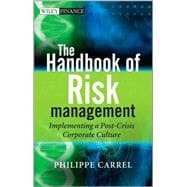
| The essence of Capitalism | |
| The move to models when risk ceased to be managed | |
| The decade of risk management | |
| Risk intelligence precedes risk management | |
| Risk management the human dimension of capitalism | |
| Risks scales and balances | |
| A risk culture is corporate DNA | |
| Distributing Risk Exposure And Sensitivity Across The Enterprise | |
| Identifying risk factors | |
| Specific risk factors | |
| Systematic risk factors | |
| Working with Risk Factors | |
| Approaching risk through sensitivity and scenarios | |
| Root-Risk Factors and Conduits of Sensitivity | |
| Back-testing and maintaining the factors | |
| Working with scenarios | |
| Scenario Definition | |
| High Severity and Worst-Case Scenarios | |
| Aggregating firm-wide risk sensitivity | |
| Aggregating Scenarios | |
| From aggregated risks to distributed risks | |
| The traditional approach by business lines leads to rely on modeling | |
| Distributing risk by risk factors leads to creation of a culture | |
| Distributed risk implies data analysis | |
| Creating and adaptive information workflow | |
| Getting the system to evolve | |
| Moving on to the next step | |
| Empowering Business Units With Risk Management Capabilities | |
| Allocating risk management capabilities | |
| Business managers are risk managers | |
| The role of Executive Risk Committees | |
| The role of Audit and Control units | |
| Mitigation strategies and hedging tactics | |
| Front-line business units | |
| Operational units | |
| Management | |
| Risk Committees and audit controls | |
| Risk independence or indifference to risk? | |
| Role of the shareholders and non-executive directors | |
| Responsibility and accountability | |
| Control and report hierarchy | |
| Risk weighted performance | |
| Principles of risk weighted measurements | |
| From risk appetite to risk policies | |
| Creating An Information Workflow For Continuous Feedback And Informed Decision Making | |
| Risk: The new bond | |
| Dynamic two-way information workflow | |
| Preventive rules for a pre-emptive course of action | |
| The dynamic assessments of risk factor sensitivities | |
| Sensitivity rules and stress tests | |
| Bottom-Up Activity Feedback | |
| Keeping a finger on the pulse | |
| Aggregating scenarios: The actual risk appetite of the firm | |
| Toward a Risk Information Bus for IT Purposes | |
| Enterprise-wide Aggregation | |
| Cross-asset sensitivity aggregation | |
| Cross-division aggregation potential pitfalls | |
| Top Down Decisions and Feedback | |
| Risk dashboards | |
| Pre-emptive decision frameworks | |
| An interactive and adaptive workflow | |
| Hierarchy, decisions, overruling | |
| Deriving a firm's Actual Observed Risk Appetite | |
| Modeling Worst Case Scenarios | |
| Risk Policies Reconciliation | |
| Aliging Funding Strategies And Liquidity Management Tactics With The Corporate Risk Policies | |
| Liquidity, the Ultimate Operational Risk | |
| Maintaining the internal balance | |
| Internal sources of liquidity risks | |
| External sources of liquidity risk | |
| Analysing and Measuring Liquidity Risks | |
| Valuation Driven Liquidity Risks | |
| Market Depth | |
| Over the Counter Markets | |
| Funding Risk | |
| Asset Liability Risks | |
| Systematic sources of liquidity risks | |
| Concentration Risks | |
| For sell-side institutions: | |
| For buy-side institutions: | |
| Managing and Mitigating Liquidity Risks | |
| Laying down the foundations of a corporate strategy | |
| Monitoring Concentrations | |
| Working with risk concentrations | |
| ALM analyses and Liquidity Management | |
| Valuations Risks | |
| Regulatory Risk | |
| Of liquidity risk and correlation | |
| Funding strategy is risk profile | |
| External Communications, Disclosure Policies & Transparency | |
| External communications | |
| Risk, the new media | |
| Disclosure policies | |
| Enhancing transparency | |
| Prices and valuations transparency | |
| Transparency of internal processes and procedures | |
| Transparency of corporate governance rules and external communications | |
| Information exchange for risk intelligence | |
| Proposal for a Global Credit and Collateral Exposure Surveillance Scheme | |
| Proposal for a taxonomy of path dependent derivatives and retail structured products | |
| Risk intelligence ratings | |
| The Regulatory Upheaval Of The 2010S | |
| The Great Unwind | |
| Regulatory reshuffle | |
| Propositions for a regulatory upheaval | |
| Propositions relating to idiosyncratic risks | |
| Propositions relating to systematic risks | |
| Propositions relating to systemic risks | |
| Table of Contents provided by Publisher. All Rights Reserved. |
The New copy of this book will include any supplemental materials advertised. Please check the title of the book to determine if it should include any access cards, study guides, lab manuals, CDs, etc.
The Used, Rental and eBook copies of this book are not guaranteed to include any supplemental materials. Typically, only the book itself is included. This is true even if the title states it includes any access cards, study guides, lab manuals, CDs, etc.